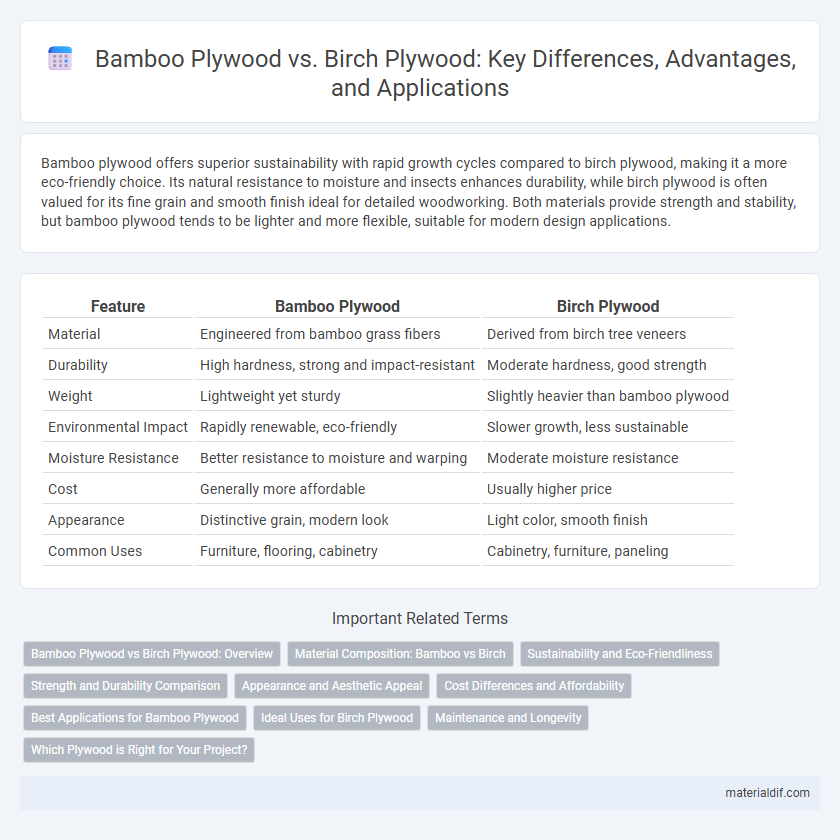Bamboo plywood offers superior sustainability with rapid growth cycles compared to birch plywood, making it a more eco-friendly choice. Its natural resistance to moisture and insects enhances durability, while birch plywood is often valued for its fine grain and smooth finish ideal for detailed woodworking. Both materials provide strength and stability, but bamboo plywood tends to be lighter and more flexible, suitable for modern design applications.
Table of Comparison
| Feature | Bamboo Plywood | Birch Plywood |
|---|---|---|
| Material | Engineered from bamboo grass fibers | Derived from birch tree veneers |
| Durability | High hardness, strong and impact-resistant | Moderate hardness, good strength |
| Weight | Lightweight yet sturdy | Slightly heavier than bamboo plywood |
| Environmental Impact | Rapidly renewable, eco-friendly | Slower growth, less sustainable |
| Moisture Resistance | Better resistance to moisture and warping | Moderate moisture resistance |
| Cost | Generally more affordable | Usually higher price |
| Appearance | Distinctive grain, modern look | Light color, smooth finish |
| Common Uses | Furniture, flooring, cabinetry | Cabinetry, furniture, paneling |
Bamboo Plywood vs Birch Plywood: Overview
Bamboo plywood offers superior sustainability due to its rapid growth rate and renewable harvesting cycle compared to birch plywood, which relies on slower-growing hardwood trees. Bamboo plywood features a unique grain pattern and higher natural resistance to moisture and insects, making it ideal for both indoor and outdoor applications, whereas birch plywood provides a smooth finish favored for cabinetry and furniture. In terms of durability, bamboo plywood exhibits greater tensile strength and flexibility, while birch plywood is noted for its consistent density and ease of staining.
Material Composition: Bamboo vs Birch
Bamboo plywood consists of layered strips of bamboo fibers glued together, resulting in a dense, durable material with a distinctive grain pattern, while birch plywood is made from thin veneers of birch wood laminated in alternating grain directions for enhanced strength. Bamboo's natural silica content contributes to its hardness and resistance to wear, contrasting with birch's fine-grain hardwood properties that provide smoothness and workability. The structural differences in fiber alignment and resin types used in bamboo and birch plywood influence their moisture resistance, durability, and suitability for specific applications such as furniture making or flooring.
Sustainability and Eco-Friendliness
Bamboo plywood is highly sustainable due to bamboo's rapid growth rate, which allows for faster replenishment compared to birch trees that take decades to mature. Bamboo's cultivation requires fewer pesticides and less water, reducing environmental impact, while birch plywood's production often involves more intensive forestry practices. The eco-friendliness of bamboo plywood is further enhanced by its carbon sequestration abilities and biodegradability, making it an excellent alternative to traditional birch plywood for environmentally conscious projects.
Strength and Durability Comparison
Bamboo plywood exhibits superior strength and durability due to its dense fiber structure and cross-laminated layers, making it more resistant to warping and cracking than birch plywood. Birch plywood, while strong and stable, tends to be slightly less durable under heavy stress and moisture exposure compared to bamboo. Enhanced tensile strength and natural resilience of bamboo plywood make it ideal for high-impact and moisture-prone applications.
Appearance and Aesthetic Appeal
Bamboo plywood showcases a unique, natural grain pattern with smooth, linear strips that create a contemporary and eco-friendly appearance, often featuring warm golden hues. Birch plywood offers a more uniform, fine grain with a light, creamy tone that provides a clean and classic look ideal for modern or traditional interiors. Both materials enhance aesthetic appeal but cater to different design preferences--bamboo for rustic or sustainable themes, birch for sleek and minimalistic styles.
Cost Differences and Affordability
Bamboo plywood generally offers a more affordable option compared to birch plywood due to its rapid growth rate and sustainable harvesting practices, reducing raw material expenses. Birch plywood tends to have higher costs reflecting its denser wood, increased processing requirements, and premium aesthetic appeal. For budget-conscious projects, bamboo plywood provides excellent cost-efficiency without compromising strength and durability.
Best Applications for Bamboo Plywood
Bamboo plywood excels in sustainable construction and cabinetry due to its high durability, moisture resistance, and eco-friendly properties compared to birch plywood. It is ideal for flooring, furniture, and kitchen applications where strength and resistance to humidity are crucial. Bamboo plywood's rapid renewability and natural anti-bacterial properties make it a preferred choice for environmentally conscious projects.
Ideal Uses for Birch Plywood
Birch plywood excels in applications requiring smooth finish and high durability, such as cabinetry, furniture, and interior paneling. Its consistent grain and strength make it ideal for precision woodworking and decorative elements. Compared to bamboo plywood, birch plywood provides superior stability for projects demanding fine detail and structural integrity.
Maintenance and Longevity
Bamboo plywood offers superior durability and requires minimal maintenance due to its natural resistance to moisture, insects, and warping compared to birch plywood. Birch plywood, while sturdy and smooth, demands regular sealing and careful protection from water to prevent delamination and swelling. Bamboo plywood's longevity is enhanced by its renewable growth cycle and harder surface, making it ideal for high-traffic or humid environments.
Which Plywood is Right for Your Project?
Bamboo plywood offers exceptional sustainability, moisture resistance, and durability, making it ideal for eco-friendly construction and furniture projects exposed to humidity. Birch plywood provides a smooth finish, excellent strength, and stability, perfect for detailed cabinetry, cabinetry, and indoor applications requiring a fine appearance. Choosing between bamboo and birch plywood depends on project priorities like environmental impact, moisture exposure, and desired aesthetic quality.
Bamboo Plywood vs Birch Plywood Infographic

 materialdif.com
materialdif.com